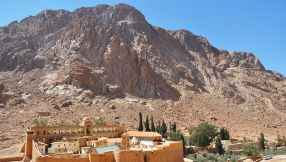The resurrection of Christ is the decisive moment in the Easter story: the crucified Christ defies death in his shocking, earth-quaking return to life. But Matthew's Gospel gives one brief yet startling detail of events around Jesus' resurrection that can easily confuse. Is this the biblical zombie story the church likes to forget?
Closing the crucifixion story, Matthew's gospel says:<sup>
'And when Jesus had cried out again in a loud voice, he gave up his spirit. At that moment the curtain of the temple was torn in two from top to bottom. The earth shook, the rocks split and the tombs broke open. The bodies of many holy people who had died were raised to life. They came out of the tombs after Jesus' resurrection and went into the holy city and appeared to many people. When the centurion and those with him who were guarding Jesus saw the earthquake and all that had happened, they were terrified, and exclaimed, "Surely he was the Son of God!"'(Matthew 27: 50-54).
To the popular imagination, this tale might seem suggestive of a zombie horror: tombs crack open, the dead walk and march upon civilisation. Perhaps it's not meant to be scary, but it's jarring on many levels and it's not clear what we're meant to feel about this moment.

For one, it feels like a distracting sideshow to Christ's resurrection, which we've not seen yet – isn't Jesus' resurrection meant to be the central, unique event that promises hope beyond death? Why are others' coming back to life? It poses a theological puzzle about the nature of these resurrected bodies – are they, like Lazarus, destined to die again? Why have these 'saints' been raised at this moment, if the resurrection of all humanity is yet to come? Again the brevity seems odd – if the dead are walking and 'appeared to many', why do we hear no more about them?
Suffice to say, it's a moment that has confused scholars and laity alike – and there's no simple explanation for it. The ESV Study Bible suggests that the raised saints (the Greek is technically 'those who had fallen asleep', the same expression found to describe the dead in 1 Corinthians 15:20) are 'probably pious OT figures and godly intertestamental Jews, reembodied to witness to the new order of things that was no in the process of dawning'. This speculation thus links the walking dead to the Messiah's miraculous return: it is a foretaste of the general resurrection to come, made possible by Christ.
The ESV further suggests that this language of being 'raised', proximate to Christ's resurrection, means the saints have indeed received their 'new resurrection bodies' (undying, unlike Lazarus who would die again). Since no other historical information about this return exists, the saints 'may have been taken up to heaven at or after Jesus' ascension'.
Pre-eminent New Testament scholar NT Wright has become famous, among other things, for his influential Easter-themed tome: The Resurrection of the Son of God. There he too puzzles over Matthew's 'extra-ordinary' account. He suggests clear allusions to Old Testament promises of resurrection, such as Ezekiel 32:12-13, which God says he will 'open your graves and lead you out of your graves'. Isaiah 26:19 and Daniel 12:2 also speak of the entombed rising and the awakening of those 'asleep'. The evangelist may be trying to include a strange story of which he had heard, while making resonant biblical allusions.
Matthew 'knows perfectly well', Wright says, that these raised saints are no longer walking around, writing as he is decades after Christ. Though the story isn't explained by Matthew, he may just be suggesting a 'strange semi-anticipation' of the great resurrection to come.
Though its historicity cannot be corroborated elsewhere, Wright notes that the story is so lacking in precedent that it would seem strange to simply invent it. Ultimately, it may be better to 'remain puzzled' than to simply dismiss the story or make an ambitious argument for it.
Wright concludes: 'Some stories are so odd that they may just have happened. This may be one of them, but in historical terms there is no way of finding out.'
This obscure tale certainly poses more questions than it answers, but in that it may provide a helpful push-back against efforts to easily explain or rationalise every part of Scripture's story. Matthew must have known it to be odd, yet he kept it, and the church preserved his account.
It is dramatic and mysterious, but that doesn't seem wholly inappropriate in a chapter about death-defying miracles and foretelling the apocalyptic fate of humankind. Resurrection probably should be strange and surprising: Easter preachers can be content to stand perplexed alongside their fellow readers.













